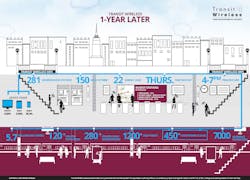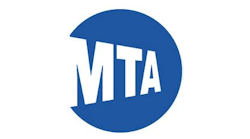One Year After Launch, Underground Wireless and Cellular Connectivity a Smash Hit
Since its completion one year ago, the popularity of seamless cellular coverage in subway stations and platforms, along with the public access Transit Wireless WiFi network, has continued to grow. During 2017, more than 280 million cellular calls originated within the underground subway stations, and 120 million Wi-Fi log-ins were made to the public Wi-Fi network. The network has also handled countless text messages, app usage, and all of the many ways consumers use their smartphones.
In addition to supporting public services, the network also delivers dedicated bands for emergency and operational services. Transit Wireless has worked hand-in-hand with the Metropolitan Transportation Authority (MTA) to deliver and support improvements like Help Point Kiosks and system-wide countdown clocks.
“With hundreds of millions of calls and Wi-Fi log-ins tallied during the course of 2017, our customers have sent a clear message that they want to stay connected during their commute,” commented Joseph J. Lhota, chairman, MTA. “Even more importantly, heightened connectivity has provided us with additional capacity for emergency communications, as well as new digital platforms that help us share information with our customers.”
“Wi-Fi and cell connectivity are great tools to help our customers stay in touch with their families, friends and work, access books and entertainment, and so much more. We’re thrilled that so many New Yorkers and visitors have made use of these services during the first full year of operation,” commented Veronique Hakim, managing director, MTA.
Transit Wireless was created to execute on the MTA’s vision to develop a shared wireless infrastructure within the underground stations of the New York City subway, including connectivity services for AT&T, Sprint, T-Mobile and Verizon Wireless customers. Since its inception, this cellular and Transit Wireless WiFi network has been connecting customers to the digital world as they make their daily commutes. Transit Wireless financed, designed, constructed, and now operates the cellular and Wi-Fi subway station networks. The company is also one of four finalists in the Governor’s public MTA Genius Challenge, which aims to deliver additional network expansions to support the subway system.
William A. Bayne, Jr., CEO of Transit Wireless, stated, “The adoption of the network among subway riders has been incredible. It’s being put to the test every day by customers streaming videos or music, downloading a book or podcast; the demand is strong and the network is fulfilling a great need.”
He continued, “Our network infrastructure goes way beyond public cellular and Wi-Fi— it is helping to revolutionize how the MTA communicates with riders underground. Whether it’s through enhancing public safety communications, or the system-wide Wi-Fi train arrival displays, we are augmenting the future of transit technological applications.”
Transit Wireless’ 27-year partnership agreement with the MTA to design, build, operate and maintain cellular and public Wi-Fi connectivity in the underground subway stations comes at no cost to taxpayers. The company has invested more than $350 million into this complex transit communications infrastructure that, in addition to cellular and Wi-Fi connectivity, incorporates public safety communications through new Help Point Kiosks; a 150-mile fiber optic backbone; and five highly secure base station data centers.
Bringing Cellular Service Underground
The fully operational network provides a great benefit to cellular carriers, as customers now have a seamless transition from aboveground to belowground cellular connections.
Marissa Shorenstein, president, Northeast Region, AT&T said: “Just a few years ago, underground wireless service was a novelty. Today it’s an essential part of riding the subways. Network use among AT&T customers underground is up 111 percent over 2016, further evidence New Yorkers want the ability to connect no matter where they are in their daily commutes. We look forward to continuing our work with Transit Wireless and the MTA to provide fast and reliable service wherever our customers demand it.”
“Since we started the installation of Wi-Fi and cellular service in the subway system a year ago, we’ve witnessed a real desire among New Yorkers to be able to use their mobile devices to stream video, music and use apps while traveling underground,” said Mark Walker, Sprint’s network vice president. “With increases of more than 200 percent in data usage and more than 400 percent in text message usage across our NYC subway sites over the last year, Sprint customers are doing more with their devices while in transit. This project has really driven data, voice and text usage way up with our customers.”
Tom Ellefson, SVP engineering, T-Mobile: “We love to see that T-Mobile customers who live, play, and work in New York City have taken advantage of the added connectivity in the subway stations as they go about their busy lives. Whether they’re exploring the city streets above ground or taking the train, T-Mobile customers can count on America’s best unlimited network to keep them connected. We’re very excited to be celebrating this one-year milestone and look forward to many more!”
Leecia Eve, Verizon Wireless, vice president, state government affairs said, "Our customers depend on our reliable wireless service wherever they are. Extending our industry-leading connectivity onto subway platforms has improved travel for millions of commuters and visitors. Subway riders can now get that important call or text and enjoy social media.”
Wi-Fi Network Favorites
The public network has proven a hit with residents, commuters and tourists alike. Transit Wireless WiFi customers now consume more than 500 terabytes of data monthly. To put that in perspective, that’s the equivalent of 5.4 billion cat memes.
Video streaming contributes most of the traffic on the network, while social media applications have the most users. Among the social media apps, Facebook is the most popular, followed by Instagram.
“The network is already handling the incredible cellular and Wi-Fi demand, and we’re prepared to scale and handle more – more logins, more data, more calls, and more services to support the public and the MTA, and to continue the progression of making New York City a Smart City,” said Bayne.
Deemed the “Crossroads of the World,” the Times Square subway station records the highest number of Wi-Fi network logins, followed by Union Square and 34th Street-Herald Square in Manhattan. In the outer boroughs, Atlantic Avenue–Barclays Center claims first place in Brooklyn, Roosevelt Avenue tops the list in Queens, and 149th Street-Grand Concourse leads the way in the Bronx. Data further shows that the network averages nearly 400,000 logins each weekday with the busiest hours from 4-7 p.m., when New Yorkers may be checking social media, exploring dinner options, catching up on the evening news, or planning their journey home. On September 14th, the network received the most logins of the year, possibly as a result of New Yorkers scouring for news of Hurricane Irma.



